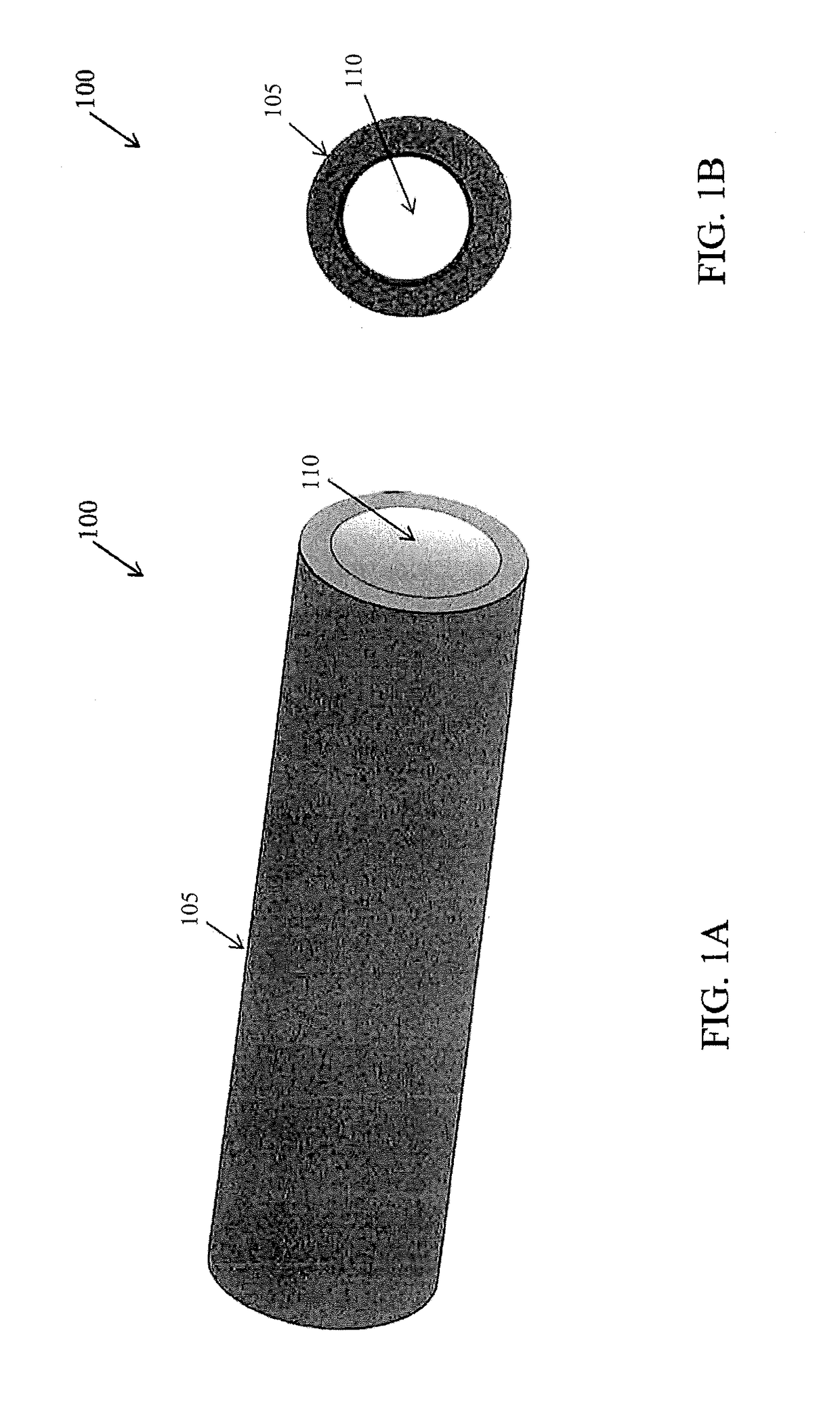Flow processing and characterization of metal-organic framework (MOF) membranes in hollow fiber and tubular modules
a technology of metal-organic framework and hollow fiber, which is applied in the direction of semi-permeable membranes, membrane technology, chemistry apparatus and processes, etc., can solve the problems of limiting the inner surface of the controlled membrane, the inability to easily scale up and down, and the limitation of the control process is particularly severe, so as to eliminate the damage to the membrane during module construction and handling, the effect of accurately controlling the growth variables and post-treatment treatmen
- Summary
- Abstract
- Description
- Claims
- Application Information
AI Technical Summary
Benefits of technology
Problems solved by technology
Method used
Image
Examples
example 1
[0134]First, about 10 mL of neat 1-octanol solvent was flowed through a bore 110 using a syringe pump.
[0135]Second, about 3 mL of a Zn+2 / 1-octanol solution containing 0.11 g Zinc nitrate hexahydrate (Zn+2) in about 40 mL 1-octanol (about 0.018 mol / L) was flowed through the bore 110 of a horizontal hollow fiber 100 at a flow rate of about 10 μL / hour. In an embodiment, a limited Zn+2 / 1-octanol solution containing about 0.005 mol / L to about 0.1 mol / L Zn+2 in 1-octanol may be used. In an embodiment, a limited Zn+2 / 1-octanol solution containing about 0.01 mol / L to about 0.03 mol / L Zn+2 in 1-octanol may be used. Increasing the Zn+2 concentration to about 0.03 mol / L leads to reduction of the membrane thickness and increase in crystal nucleation.
[0136]About 70 mL of an aqueous mIm solution containing about 9 g mIm in about 80 mL dionized water (DI) (about 1.37 mol / L) was slowly poured into the reactor module 400, immersing the outer (shell) side surface 105 of the hollow fiber 100. In an em...
example 2
[0140]First, about 10 mL DI was first flowed through the bore 110 followed by about 3 mL of an aqueous Zn+2 (bore) solution (about 0.018 mol / L). About 70 mL of an aqueous mIm solution (about 1.37 mol / L) was added to the outer (shell) side surface 105 (i.e., slowly poured into the reactor module 400 and was gently stirred at about 60 rpm to prevent the formation of local concentration gradients) while the aqueous Zn+2 (bore) solution was flowed at about 10 μL / hour for about 2 hours. After about 2 hours of bore solution flow, the pump was stopped for about 3.5 hours to provide a static growth step. After about 3.5 hours, the pump was continued for about 20 minutes. After about 20 minutes, the pump was stopped for another 3.5 hours to provide another static growth step.
[0141]To stop the reaction, about 20 mL DI was flowed through the bore 110 while the outer (shell) side surface 105 was soaked in about 70 mL of neat DI (and replaced three times) to remove the excess Zn+2. Then, about 2...
example 3
[0142]First, about 10 mL 1-octanol was first flowed through the bore 110 followed by about 3 mL of a Zn+2 / 1-octanol (bore) solution (about 0.018 mol / L). About 70 mL of an mIm / 1-octanol solution (about 1.37 mol / L) was added to the outer (shell) side surface 105 while the Zn+2 / 1-octanol (bore) solution was flowed at about 10 μL / hour for about 2 hours. After about 2 hours of bore solution flow, the pump was stopped for about 3.5 hours to provide a static growth step. After about 3.5 hours, the pump was continued for about 20 minutes. After about 20 minutes, the pump was stopped for another 3.5 hours to provide another static growth step.
[0143]To stop the reaction, about 10 mL neat 1-octanol solvent was pushed through the bore 110 while the outer (shell) side surface 105 was soaked in about 70 mL of neat 1-octanol solvent. Then, about 10 mL of heptanes were pushed through the bore 110 while the outer (shell) side surface 105 was soaked in about 70 mL of heptanes to remove the 1-octanol....
PUM
| Property | Measurement | Unit |
|---|---|---|
| flow rates | aaaaa | aaaaa |
| outer diameter | aaaaa | aaaaa |
| diameter | aaaaa | aaaaa |
Abstract
Description
Claims
Application Information
 Login to View More
Login to View More - R&D
- Intellectual Property
- Life Sciences
- Materials
- Tech Scout
- Unparalleled Data Quality
- Higher Quality Content
- 60% Fewer Hallucinations
Browse by: Latest US Patents, China's latest patents, Technical Efficacy Thesaurus, Application Domain, Technology Topic, Popular Technical Reports.
© 2025 PatSnap. All rights reserved.Legal|Privacy policy|Modern Slavery Act Transparency Statement|Sitemap|About US| Contact US: help@patsnap.com



